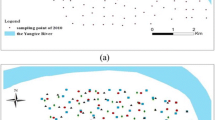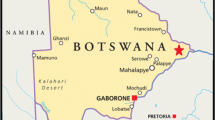Abstract
Accurate characterization of heavy-metal contaminated areas and quantification of the uncertainties inherent in spatial prediction are crucial for risk assessment, soil remediation, and effective management recommendations. Topsoil samples (0–15 cm) (n = 547) were collected from the Zhangjiagang suburbs of China. The sequential indicator co-simulation (SIcS) method was applied for incorporating the soft data derived from soil organic matter (SOM) to simulate Hg concentrations, map Hg contaminated areas, and evaluate the associated uncertainties. High variability of Hg concentrations was observed in the study area. Total Hg concentrations varied from 0.004 to 1.510 mg kg−1 and the coefficient of variation (CV) accounts for 70%. Distribution patterns of Hg were identified as higher Hg concentrations occurred mainly at the southern part of the study area and relatively lower concentrations were found in north. The Hg contaminated areas, identified using the Chinese Environmental Quality Standard for Soils critical values through SIcS, were limited and distributed in the south where the SOM concentration is high, soil pH is low, and paddy soils are the dominant soil types. The spatial correlations between Hg and SOM can be preserved by co-simulation and the realizations generated by SIcS represent the possible spatial patterns of Hg concentrations without a smoothing effect. Once the Hg concentration critical limit is given, SIcS can be used to map Hg contaminated areas and quantitatively assess the uncertainties inherent in the spatial prediction by setting a given critical probability and calculating the joint probability of the obtained areas.
Similar content being viewed by others
References
Atteia, O., Dubois, J. P., & Webster, R. (1994). Geostatistical analysis of soil contamination in the Swiss Jura. Environmental Pollution, 86, 315–327.
Broos, M. J., Aarts, L., Van Tooren, C. F., & Stein, A. (1999). Quantification of the effects of spatial varying environmental contaminants into a cost model for soil remediation. Journal of Environmental Management, 56, 133–145.
Cattle, J. A., McBratney, A. B., & Minasny, B. (2002). Kriging method evaluation for assessing the spatial distribution of urban soil lead contamination. Journal of Environmental Quality, 31, 1576–1588.
C. V. Deutsch & A. G. Journel (Eds.) (1998). GSLIB, Geostatistical software library and user’s guide. New York: Oxford University Press.
Facchinelli, A., Sacchi, E., & Mallen, L. (2001). Multivariate statistical and GIS-based approach to identify heavy metal sources in soils. Environmental Pollution, 114, 313–324.
Franco, C., Soares, A., & Delgado, J. (2006). Geostatistical modelling of heavy metal contamination in the topsoil of Guadiamar river margins (S Spain) using a stochastic simulation technique. Geoderma, 136, 852–864.
Franssen, H. J. W. M. H., van Eijnsbergen, A. C., & Stein, A. (1997). Use of spatial prediction techniques and fuzzy classification for mapping soil pollutants. Geoderma, 77, 243–262.
General Environment Monitoring Station of China (GEMSC) (1992). Modern analysis methods for soil elements (in Chinese). Beijing: China Environment Science.
Goovaerts, P. (1999). Geostatistics in soil science: State-of-the-art and perspectives. Geoderma, 89, 1–45.
Goovaerts, P. (2001). Geostatistical modeling of uncertainty in soil science. Geoderma, 103, 3–26.
Hendriks, L. A. M., Leummens, H., Stein, A., & de Bruijn, P. J. (1998). Use of soft data in a GIS to improve estimation procedures for environmental purposes. Water, Air and Soil Pollution, 101, 217–234.
E. H. Isaaks & R. M. Srivastava (Eds.) (1989). An introduction to applied geostatistics. New York: Oxford University Press.
Juang, K. W., Chen, Y. S., & Lee, D. Y. (2004). Using sequential indicator simulation to assess the uncertainty of delineating heavy-metal contaminated soils. Environmental Pollution, 127, 229–238.
R. K. Lu (Eds.) (2000). Analysis method of soil and agricultural chemistry. Beijing: China Agricultural Science & Technology.
Martin, H. W., & Kaplan, D. I. (1998). Temporal changes in cadmium, thallium, and vanadium mobility in soil and phytoavailability under field conditions. Water, Air, and Soil Pollution, 101, 399–410.
Meuli, R., Schulin, R., & Webster, R. (1998). Experience with the replication of regional survey of soil pollution. Environmental Pollution, 101, 311–320.
Mohammadi, J., Van Meirvenne, M., & Goovaerts, P. (1997). Mapping cadmium concentration and the risk of exceeding a local sanitation threshold using indicator geostatistics. In A. Soares, J. Gomez-Hernandez, & R. Froidevaux (Eds.), geoENV I-Geostatistics for environmental applications (pp. 327–337). Dordrecht: Kluwer.
Park, S. J., & Vlek, P. L. G. (2002). Environmental correlation of three-dimensional soil spatial variability: A comparison of three adaptive techniques. Geoderma, 109, 117–140.
Regli, C., Rosenthaler, L., & Huggenberger, P. (2004). GEOSSAV: A simulation tool for subsurface applications. Computers & Geosciences, 30, 221–238.
Shao, X. X., Huang, B., Gu, Z. Q., Qian, W. F., Jin, Y., Bi, K. S., et al. (2006). Spatial-temporal variation of pH values of soils in a rapid economic developing area in the Yangtze River Delta region and their causing factors (in Chinese). Bulletin of Mineralogy Petrology and Geochemistry, 25(2), 143–149.
Soil Survey Office of Shazhou County (SSOSC) (1984). Description of soils in Shazhou county (in Chinese). Agriculture Bureau of Suzhou City, Jiangsu Provincial Office for Soil Survey.
Soil Taxonomy Research Group (STRG) (2001). Key to Chinese soil taxonomy (in Chinese). Hefei: University of Science & Technology of China.
R. Webster & M. A. Oliver (Eds.) (2000). Geostatistics for environmental scientists. New York: Wiley.
Zhang, C. S., & Selinus, O. (1997). Spatial analyses for copper, lead and zinc contents in sediments of the Yangtze River basin. Science of the Total Environment, 204, 251–262.
Author information
Authors and Affiliations
Corresponding author
Rights and permissions
About this article
Cite this article
Zhao, Y., Xu, X., Sun, W. et al. Uncertainty assessment of mapping mercury contaminated soils of a rapidly industrializing city in the Yangtze River Delta of China using sequential indicator co-simulation. Environ Monit Assess 138, 343–355 (2008). https://doi.org/10.1007/s10661-007-9802-3
Received:
Accepted:
Published:
Issue Date:
DOI: https://doi.org/10.1007/s10661-007-9802-3




